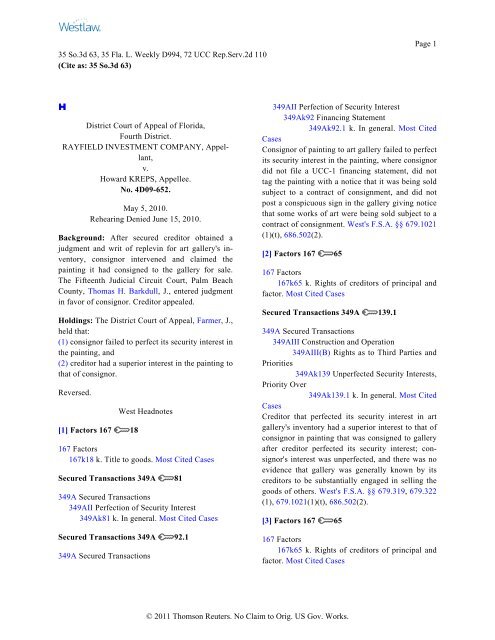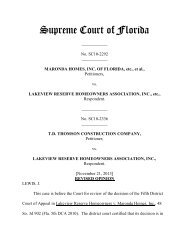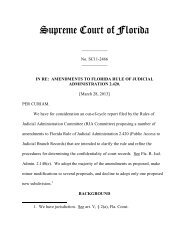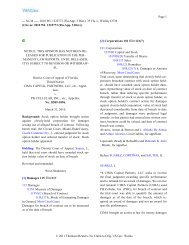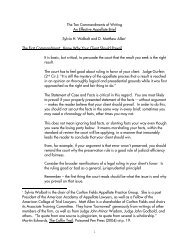Rayfield Investment Co. v. Kreps - Carlton Fields
Rayfield Investment Co. v. Kreps - Carlton Fields
Rayfield Investment Co. v. Kreps - Carlton Fields
Create successful ePaper yourself
Turn your PDF publications into a flip-book with our unique Google optimized e-Paper software.
35 So.3d 63, 35 Fla. L. Weekly D994, 72 UCC Rep.Serv.2d 110(Cite as: 35 So.3d 63)Page 1District <strong>Co</strong>urt of Appeal of Florida,Fourth District.RAYFIELD INVESTMENT COMPANY, Appellant,v.Howard KREPS, Appellee.No. 4D09-652.May 5, 2010.Rehearing Denied June 15, 2010.Background: After secured creditor obtained ajudgment and writ of replevin for art gallery's inventory,consignor intervened and claimed thepainting it had consigned to the gallery for sale.The Fifteenth Judicial Circuit <strong>Co</strong>urt, Palm Beach<strong>Co</strong>unty, Thomas H. Barkdull, J., entered judgmentin favor of consignor. Creditor appealed.Holdings: The District <strong>Co</strong>urt of Appeal, Farmer, J.,held that:(1) consignor failed to perfect its security interest inthe painting, and(2) creditor had a superior interest in the painting tothat of consignor.Reversed.[1] Factors 167 18West Headnotes167 Factors167k18 k. Title to goods. Most Cited CasesSecured Transactions 349A 81349A Secured Transactions349AII Perfection of Security Interest349Ak81 k. In general. Most Cited CasesSecured Transactions 349A 92.1349A Secured Transactions349AII Perfection of Security Interest349Ak92 Financing Statement349Ak92.1 k. In general. Most CitedCases<strong>Co</strong>nsignor of painting to art gallery failed to perfectits security interest in the painting, where consignordid not file a UCC-1 financing statement, did nottag the painting with a notice that it was being soldsubject to a contract of consignment, and did notpost a conspicuous sign in the gallery giving noticethat some works of art were being sold subject to acontract of consignment. West's F.S.A. §§ 679.1021(1)(t), 686.502(2).[2] Factors 167 65167 Factors167k65 k. Rights of creditors of principal andfactor. Most Cited CasesSecured Transactions 349A 139.1349A Secured Transactions349AIII <strong>Co</strong>nstruction and Operation349AIII(B) Rights as to Third Parties andPriorities349Ak139 Unperfected Security Interests,Priority Over349Ak139.1 k. In general. Most CitedCasesCreditor that perfected its security interest in artgallery's inventory had a superior interest to that ofconsignor in painting that was consigned to galleryafter creditor perfected its security interest; consignor'sinterest was unperfected, and there was noevidence that gallery was generally known by itscreditors to be substantially engaged in selling thegoods of others. West's F.S.A. §§ 679.319, 679.322(1), 679.1021(1)(t), 686.502(2).[3] Factors 167 65167 Factors167k65 k. Rights of creditors of principal andfactor. Most Cited Cases© 2011 Thomson Reuters. No Claim to Orig. US Gov. Works.
35 So.3d 63, 35 Fla. L. Weekly D994, 72 UCC Rep.Serv.2d 110(Cite as: 35 So.3d 63)Page 2Secured Transactions 349A 139.1349A Secured Transactions349AIII <strong>Co</strong>nstruction and Operation349AIII(B) Rights as to Third Parties andPriorities349Ak139 Unperfected Security Interests,Priority Over349Ak139.1 k. In general. Most CitedCasesTo satisfy the requirement that a consignee be generallyknown by its creditors to be substantially engagedin selling the goods of others, in order to defeatthe priority of secured creditors, a consignormust show that a majority of the consignee's creditorswere aware that the consignee was substantiallyengaged in selling the goods of others by consignmentsales, and the majority is determined by thenumber of creditors, not by the amount of theirclaims. West's F.S.A. § 679.1021(1)(t).*64 James K. Green of James K. Green, P.A., WestPalm Beach, for appellant.Howard <strong>Kreps</strong>, Miami, appellee.FARMER, J.Opposing creditors clash over security interests in apainting found in the inventory of a failed art gallery.One creditor is its operating capital lenderclaiming a perfected security interest in all its inventory.The other is a consignor who placed apainting with the gallery for sale but without perfectinghis interest in the consigned goods. <strong>Co</strong>ncludingthat the governing statutes for security interestsgive the priority to the lender, we reverse thejudgment awarding the painting to the consignor.Lender made a series of loans totaling $300,000over a three-year period to a New York corporationdoing business in Palm Beach under the trade nameStyle de Vie. Apparently its lifestyle did not allow itto pay its lender, for the gallery defaulted on theloan. Lender sued to foreclose its security intereston the gallery's inventory. Lender proved nonpaymentand that it had perfected its security interestby filing a UCC-1 financing statement inFlorida. Lender obtained a judgment and a writ ofreplevin for the inventory.<strong>Co</strong>nsignor intervened after lender's replevin of theinventory and claimed the painting. The evidenceshowed that he placed the painting with the galleryafter lender's security interest had been perfected.FN1 He did not attach any tag or legend to thepainting that it was on consignment. FN2 Nor did hefile a UCC-1 financing statement in Florida givingnotice of his prior interest in the painting. Followinga trial, the court found consignor's interest superiorto lender's perfected interest, reasoning:FN1. The painting was by an artist named<strong>Co</strong>rtes. The consignment agreement statedthat gallery was free to sell for not lessthan $42,000.FN2. Florida law requires the consignor ofworks of art to give notice to the public by:“affixing to such work of art a sign ortag which states that such work of art isbeing sold subject to a contract of consignment,or such consignee shall post aclear and conspicuous sign in the consignee'splace of business giving noticethat some works of art are being soldsubject to a contract of consignment.”§ 686.502(2), Fla. Stat. (2009).“[lender] had actual knowledge that [gallery] soldantiques and other goods on consignment. Specifically... [lender] entered into a Profit ParticipationAgreement with [gallery] which contemplatedparticipation in the profits of the sales ofconsigned goods. Further ... [lender] had actualknowledge and contemplated*65 the continuingconsignment of goods at [gallery], and contemplatedparticipation in the profits from the sale ofconsigned goods. [<strong>Co</strong>nsignor] has shown by clearand convincing evidence that he has a superior© 2011 Thomson Reuters. No Claim to Orig. US Gov. Works.
35 So.3d 63, 35 Fla. L. Weekly D994, 72 UCC Rep.Serv.2d 110(Cite as: 35 So.3d 63)Page 3right and title to the painting that is the subject ofthis law suit.”From the judgment in consignor's favor, lenderappeals.The Florida Uniform <strong>Co</strong>mmercial <strong>Co</strong>de (UCC)governs sales and secured transactions. The UCCspecifies that the term “security interest” means “aninterest in personal property ... which secures paymentor performance of an obligation” and“includes any interest of a consignor....” §671.201(35), Fla. Stat. (2009). As for consignments,UCC Article 9 further specifies:“<strong>Co</strong>nsignment means a transaction, regardless ofits form, in which a person delivers goods to amerchant for the purpose of sale and:1. The merchant deals in goods of that kind undera name other than the name of the personmaking delivery; is not an auctioneer; and is notgenerally known by its creditors to be substantiallyengaged in selling the goods of others;2. With respect to each delivery, the aggregatevalue of the goods is $1,000 or more at the timeof delivery;3. The goods are not consumer goods immediatelybefore delivery; and4. The transaction does not create a security interestthat secures an obligation.” [internal subheadingsomitted]§ 679.1021(1)(t), Fla. Stat. (2009). Again the recordindisputably shows that consignor did nothing toperfect a prior interest in the painting by filing aUCC-1, by affixing a tag or by having the gallerypost a sign that some inventory is on consignment.At trial consignor presented evidence that lender'sprincipal knew some of the gallery's items were onconsignment. The lender's principal complainedthat the gallery failed to furnish inventories duringthe three years before the consignment. When he finallyreceived an inventory, it listed several thousanditems for sale but there were not more than 60at the time. According to some records, consignmentgoods never exceeded 15% of inventory in thefew years preceding the store's demise.[1] While lender knew there were some consignmentgoods for sale, there is absolutely no recordevidence as to whether the gallery was “generallyknown by its creditors to be substantially engagedin selling the goods of others.” § 679.1021(1)(t)1c.<strong>Co</strong>nsignor presented no evidence as to who or howmany creditors the gallery had when he placed hispainting there for sale in 2006. Similarly there is noevidence that lender knew this painting was on consignmentor of any agreement between the galleryand consignor. So it is clear this case involves a priorperfected security interest in inventory and asubsequent unperfected security interest in a paintingplaced with the gallery for sale on consignment.[2] The law does not support the trial judge's decision.The Florida UCC explicitly provides that aperfected security interest in goods takes priorityover all subsequently perfected and unperfected securityinterests in the same goods. § 679.322(1),Fla. Stat. (2009). Florida law also explicitlyprovides that a consignor's interest in goods placedfor sale with a consignee who routinely sells suchgoods is merely an unperfected security interestsubject to the claims of those with prior perfectedsecurity interests. See §§ 679.319 and679.322(1)(b), Fla. Stat. *66 (2009); see also In re<strong>Co</strong>rvette <strong>Co</strong>llection of Boston Inc., 294 B.R. 409,414 (Bkry.S.D.Fla.2003) (holding that as to consignedgoods, presumption is that goods are held byconsignee on sale or return basis subject to claimsof consignee's creditors).The consignor in this case could have defeated thepriority of secured creditors only by proving that amajority of the gallery's creditors knew that it wassubstantially engaged in consignment sales. See e.g.<strong>Co</strong>rvette <strong>Co</strong>llection, 294 B.R. at 414. But consignoroffered no evidence as to who the gallery's creditorswere or what they knew about his goods for sale.The cases follow a general rule of thumb that con-© 2011 Thomson Reuters. No Claim to Orig. US Gov. Works.
35 So.3d 63, 35 Fla. L. Weekly D994, 72 UCC Rep.Serv.2d 110(Cite as: 35 So.3d 63)Page 4signees are not considered to be “substantially engaged”in selling the goods of others unless theyhold at least 20% of inventory on a consignmentbasis. See In re Valley Media Inc., 279 B.R. 105,125 (Bkry.D.Del.2002); see also In re Wedlo HoldingsInc., 248 B.R. 336, 342 (Bkry.N.D.Ill.2000)(holding as a matter of law that consignee who obtainedonly 15% to 20% of its inventory on consignmentwas not substantially engaged in sellinggoods of others).[3] To satisfy the “generally known” requirement, aconsignor must show that a majority of the consignee'screditors were aware that the consignee wassubstantially engaged in selling the goods of othersby consignment sales, and the majority is determinedby the number of creditors, not by the amountof their claims. See Valley Media, 279 B.R. at 126;In re Wicaco Mach. <strong>Co</strong>rp., 49 B.R. 340, 344(E.D.Pa.1984) (holding that 20% of creditors knowingof consignment relationship does not satisfygeneral knowledge requirement, notwithstandingthat such creditors represented 63% of claimsagainst debtor). Again, here the consignor had noidea who or how many creditors the gallery had.<strong>Co</strong>nsignor's case authorities are inapposite, for theyinvolve actual knowledge by the lender of a specificconsignment.This case is factually similar to Valley Media.There, some of the debtor's vendors had entered intoconsignment arrangements with the debtor beforethe debtor filed for bankruptcy. 279 B.R. 105 at115. The consigned inventory was commingledwith all of the other inventory of the debtor at twowarehouse locations. 279 B.R. 105 at 116. No signswere posted at the warehouses, and there were nosigns or markings on the consigned inventory indicatingthat the inventory had been obtained on a consignmentbasis. 279 B.R. 105 at 116. When thedebtor moved the bankruptcy court to sell all of itsinventory, the consignment vendors objected, arguingthat they owned their consignment inventoryby virtue of their consignment arrangements. 279B.R. 105 at 121-22. The court observed that theconsignors could have obtained a prior interest intheir consigned goods if they had either (1) filedUCC-1 financing statements identifying their goodsas required under UCC Article 9, or (2) proved thatthe consignee was generally known by its creditorsto be substantially engaged in selling the goods ofothers. 279 B.R. at 123. See also In re New YorkDiamond & Jewelry Exch. Inc., 26 B.R. 32(Bkry.S.D.Fla.1982) (consignor failed to perfect securityinterest by filing financing statement andfailed to establish that debtor was generally knownby its creditors to be substantially engaged in saleof goods of others, had unperfected security interestin diamonds, subject to trustee's right, and sincetrustee did not have diamond among assets of estate,trustee was entitled to judgment againstplaintiff); ITT <strong>Co</strong>mmercial Fin. <strong>Co</strong>rp. v. UnlimitedAuto. Inc., 166 B.R. 637 (N.D.Ill.1994) (securedcreditor of debtor-dealer had priority over consignorof motor vehicle,*67 where consignor didnot comply with applicable filing requirements ofUCC and secured creditor enjoyed status of perfectedsecured creditor with claim to inventory ofdebtor).What this case presents is the common collisionbetween a legal rule and an opposing claim for individualizedjustice. Ours is supposed to be a rule oflaw, not of judges. Some rules of law are meant tobe categorical and unavoidable. The law requires,for example, citizenship to vote, driving on theright side of the road, recorded title to real property,timely assertion of civil claims-to mention just afew-all of which cannot be avoided by an individualclaim for sympathetic understanding. Some legalrules explicitly allow their application to be variedby individual circumstances, using equitable principles,but the commercial law on secured transactionsis not among them.The rules for acquiring and enforcing security interestswere not written to permit individualizedjustice and equity contrary to their requirements. Itwould not be much of a uniform code, for example,if legal rules on sales rights and remedies trans-© 2011 Thomson Reuters. No Claim to Orig. US Gov. Works.
35 So.3d 63, 35 Fla. L. Weekly D994, 72 UCC Rep.Serv.2d 110(Cite as: 35 So.3d 63)Page 5formed themselves from case to case, or negotiableinstruments were not predictably and reliably negotiable,or that priorities of security interests wereadjustable depending on whose individual circumstanceis more sympathetic. The statutes give us noauthority to refuse to enforce priorities under UCCArticle 9 on the basis that the painting has been inthe family for years, or that the lender knew thegallery did some consignment sales, or that thislender's funding agreement with the gallery allowedit to share to some extent in its profits, or by framingthe painting's sale as a bailment instead of aconsignment. FN335 So.3d 63, 35 Fla. L. Weekly D994, 72 UCCRep.Serv.2d 110END OF DOCUMENTFN3. See § 679.1021(1)(t), Fla. Stat.(2009) (consignment means any transaction-regardlessof its form-in which a persondelivers goods to a merchant for purposeof sale).The law creating the priority rule afforded consignoreffective tools to avoid a prior security interestin gallery's inventory. These tools weresimple, not burdensome, and easily satisfied. Heneeded only to file a UCC-1 under Florida law.Aside from that, he could have required the galleryto affix a tag onto the painting and place a signalerting prospective buyers of a consignment sale.He did none of these things. Nothing in the recordwe have been given suggests that lender or gallerydid anything to dissuade him from prior consultationwith a lawyer to protect his painting by complyingwith statutes for avoiding prior interests. Inthe end he failed to offer any evidence that most ofgallery's creditors knew that a substantial part of itssales were consignments.The judgment of the trial court is in error. The perfectedsecurity interest of lender has priority overthe claim of consignor.Reversed.HAZOURI and MAY, JJ., concur.Fla.App. 4 Dist.,2010.<strong>Rayfield</strong> Inv. <strong>Co</strong>. v. <strong>Kreps</strong>© 2011 Thomson Reuters. No Claim to Orig. US Gov. Works.


